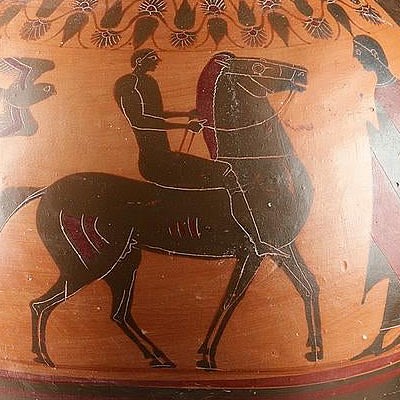Huge Roman Mosaic - Male Portrait w/ Geometric Border
Lot 66
About Seller
Artemis Fine Arts
686 S Taylor Ave, Ste 106
Louisville, CO 80027
United States
Selling antiquities, ancient and ethnographic art online since 1993, Artemis Gallery specializes in Classical Antiquities (Egyptian, Greek, Roman, Near Eastern), Asian, Pre-Columbian, African / Tribal / Oceanographic art. Our extensive inventory includes pottery, stone, metal, wood, glass and textil...Read more
Estimate:
$25,000 - $35,000
Absentee vs Live bid
Two ways to bid:
- Leave a max absentee bid and the platform will bid on your behalf up to your maximum bid during the live auction.
- Bid live during the auction and your bids will be submitted real-time to the auctioneer.
Bid Increments
| Price | Bid Increment |
|---|---|
| $0 | $25 |
| $300 | $50 |
| $1,000 | $100 |
| $2,000 | $250 |
| $5,000 | $500 |
| $10,000 | $1,000 |
| $20,000 | $2,500 |
| $50,000 | $5,000 |
| $100,000 | $10,000 |
| $200,000 | $20,000 |
About Auction
By Artemis Fine Arts
Jun 4, 2020
Set Reminder
2020-06-04 10:00:00
2020-06-04 10:00:00
America/New_York
Bidsquare
Bidsquare : Exceptional Antiquities, Asian, Ethnographic
https://www.bidsquare.com/auctions/artemis-gallery/exceptional-antiquities-asian-ethnographic-5185
An important one-day auction featuring museum-worthy examples of Egyptian, Greek, Roman, Etruscan, Near Eastern, Far East / Asian, Pre-Columbian, African / Tribal, Oceanic, Native American, Spanish Colonial, Russian, Fossils, Ancient Jewelry, Fine Art, so much more! Artemis Fine Arts info@artemisfinearts.com
An important one-day auction featuring museum-worthy examples of Egyptian, Greek, Roman, Etruscan, Near Eastern, Far East / Asian, Pre-Columbian, African / Tribal, Oceanic, Native American, Spanish Colonial, Russian, Fossils, Ancient Jewelry, Fine Art, so much more! Artemis Fine Arts info@artemisfinearts.com
- Lot Description
Roman, the Levant, late Imperial Period, ca. 3rd to 5th century CE. Impressive on so many levels, this mosaic presents a portrait of a handsome male. He is clean-shaven with deep-set eyes, an aquiline nose, closed lips, a few wrinkles under the eyes indicating his maturity, and closely cropped, wavy hair. His visage is skillfully rendered with tesserae in several colors so as to provide a sense of volume. In addition, he is softly lit so as to create a nice shadow that adds another layer of depth, all against a rose red ground. Surrounding this portrait are concentric borders - first a white band, followed by a band of repeating sky blue diamonds against a black ground; then another white band lined followed by a narrow red band; after this is a more complex geometric border of rose, russet, azure blue, dove grey, white, and golden yellow; this surrounded by a narrow red band and a wider white one; and finally, another border of repeating sky blue diamonds against a black ground. Size: 45" W x 45" H (114.3 cm x 114.3 cm); 47" W x 47" H (119.4 cm x 119.4 cm) with plaster matrix and metal frame
The Romans had a long tradition of portraiture, with portrait busts of the Republican period quite veristic in their intent, revealing every flaw of the subject. However, the relatively classicizing features of the portrait featured in this mosaic suggest that the artist was influenced by the idealism of the Augustan and Julio-Claudian Periods. Augustan and Julio-Claudian portraits emphasized the beauty of their leaders. Augustus set this precedent which was subscribed to by imperial portraiture until the reign of Constantine the Great. The Romans' idealizations of emperor's images were designed to present visual associations with their predecessors - serving as a means of legitimatizing the emperor's authority.
In the Roman province of Syria, which encompassed most of the ancient Near East/Levant, mosaics developed as a common art form relatively late, with most finds coming from the 3rd century CE or later. Syria was one of Rome's wealthiest provinces, but it was also far removed from Rome itself and Roman culture was overlaid on enduring cultural traditions from Hellenistic Greece and the great civilizations that came before it. Antioch-on-the-Orontes (modern day Antakya, Turkey), was the capital of northern Roman Syria, and its excavations in the 1930s revealed more than three hundred mosaic pavements - of which many embellished public baths. Popular mosaic themes from this region were often mythological or religious scenes, depicting gods and goddesses; however, sometimes mosaics departed from this. In this case, the Roman tradition of portraiture is embraced. Just who did this gentleman represent? A leader? The owner of the house? Patriarch of a family? We may never know his exact identity; however, it is clear that the artist strove for a likeness that was at once individualistic and flattering.
Provenance: ex-private New York, USA collection, acquired in 1980's
All items legal to buy/sell under U.S. Statute covering cultural patrimony Code 2600, CHAPTER 14, and are guaranteed to be as described or your money back.
A Certificate of Authenticity will accompany all winning bids.
We ship worldwide and handle all shipping in-house for your convenience.
#139194Expected surface wear with minor losses, nicks, fissures, recessions, and abrasions to tesserae commensurate with age. Set in a modern plaster matrix with a metal frame.Condition
- Shipping Info
-
All shipping is handled in-house for your convenience. Your invoice from Artemis Gallery will include shipping calculation instructions. If in doubt, please inquire BEFORE bidding for estimated shipping costs for individual items.
-
- Buyer's Premium



 EUR
EUR CAD
CAD AUD
AUD GBP
GBP MXN
MXN HKD
HKD CNY
CNY MYR
MYR SEK
SEK SGD
SGD CHF
CHF THB
THB
















